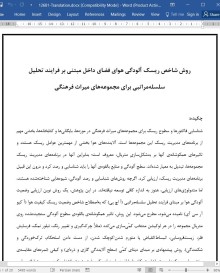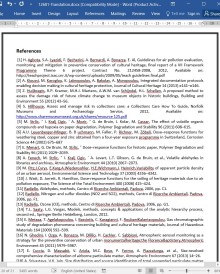
دانلود مقاله روش شاخص ریسک آلودگی هوای فضای داخل مبتنی بر فرآیند تحلیل سلسله مراتبی
چکیده
شناسایی فاکتورها و سطوح ریسک برای مجموعه های میراث فرهنگی در موزه ها، بایگانیها و کتابخانه ها، بخشی مهم از برنامه های مدیریت ریسک این مجموعه ها است. آلاینده های هوا بخشی از مهمترین عوامل ریسک هستند و تاثیرهای هم کوشانه ی آنها بر بدشکلسازیِ متریال، معروف است؛ بنابراین آنها در برنامه های مدیریت ریسک مجموعه ها، تبدیل به معیار شده اند. سطح آلودگی و منابع بالقوه ی آنها را باید شناسایی و رصد کرد و درون این قبیل برنامه های مدیریت ریسک، ارزیابی کرد. اگرچه روشهای شناسایی و رصد آلودگی، شیوههایی شناخت شده هستند، اما متدولوژی های ارزیابی، هنوز به اندازه کافی توسعه نیافته اند. در این پژوهش، یک روش نوین ارزیابی وضعیت آلودگی هوا بر مبنای فرایند تحلیل سلسله مراتبی (آ اچ پی) که به اصطلاح شاخص وضعیت ریسک کیفیت هوا (آ کیو آر سی آی) نامیده میشود، مطرح میشود. این روش، تاثیر همکوشانه ی بالقوه ی سطوح آلودگی سنجیده شده روی متریال مجموعه را در هر لوکیشن منتخب کمّی سازی میکند (مثلاً چرک گیری و تغییر رنگ، تبلور نمک، فرسایش فلز، زیست فروسایی، انبساط/انقباض یا متورم شدن/کوچک شدن، از دست دادن استحکام، ترکخوردگی و شکنندگی). روش پیشنهادی بر مبنای دیتای کمّی (سطح آلایندگی گازی و ذره ای) و کیفی (نمره های مقایسه ی جفتی برای ریسک های مرتبط) است. کاخ دلماباغچه را بعنوان یک سایت پژوهش انتخاب کردیم و جهت ارائه سطوح ریسک نسبی برای پنج مقوله ی مختلف، در چند لوکیشن مسقفی که در مجموعه ی کاخ دلماباغچه حضور داشتند، روش پیشنهادیِ آ کیو آر سی آی را بکار بردیم.
1. اهداف پژوهش
اهداف این پژوهش، ارائه ی یک فرایند تحلیل سلسله مراتبی مبتنی بر (آ اچ پی) برای سطوح آلودگی فضای مسقف و برای عوامل ریسک مرتبط با بدشکل سازی متریال است. این متدولوژی به هر کاربری اجازه میدهد، تاثیرهای بالقوه و ریسکهای سطوح آلودگی هوای فضای مسقف را که در هر لوکیشن خاصی مشاهده میشود، کمّی سازی و مقایسه کند. این روش به جای ریسک های بدشکلسازی مختص به شیء، امتیازهای آکیو آرسی آی را برای فرایندهای گوناگون زوال در متریال های گوناگون، مطرح میکند: چرک گیری و تغییر رنگ در تمام متریال، نقاشی و رنگ بنا، تبلور نم در سنگهای متخلخل و اشیاء سرامیکی، فرسایش فلزات، زیست فروسایی در سنگهای سیلیکات کربن و متریال ارگانیک و انبساط/انقباض، از دست دادن استحکام، ترک خوردگی و شکنندگی در چوب و کاغذ. این پژوهش، کاربردی از روش مطرحشده را نیز با استفاده از سنجش های آلودگی فصلی و پارامترهای مختص به سایت برای کاخ دلماباغچه ارائه میدهد. روش پیشنهادی را میتوان بهآسانی در مکانها و لوکیشنهای دیگر نیز بکار برد.
5. نتیجه
کاخ دلماباغچه دارای کنترل محیطی داخلی ضعیفی است که عمدتاً ناشی از چیدمان داخلی آن است. اتاقهای متعدد با فضای خارج کاخ در تماس هستند و فاقد درب و پنجره های غیرقابل نفوذ هستند. در تابستان نیز تهویه ی طبیعی انجام میشود، یعنی پنجرهها طی ساعات بازدید باز هستند تا بازدیدکنندگان راحت باشند. بدیهی است که این ویژگیها مشخصه های لوکیشنهای این کاخ را تعیین میکنند که تحت تاثیر زیاد شرایط آب وهوایی بیرون از بنا و نوسانهای فصلی شدید هست. تاثیر چرک گیری طی زمستان در تالارهای مدهال و سوفرا بیشتر بود و تفاوتهای آنها قابلتوجه بود. تالار سوفرا پرریسکترین مکان در کاخ دلماباغچه بود، به این دلیل که سطوح بالاتری از گازهای واکنشیِ دارای منشاء خارجی داشت. همچنین مشخص شد که تالار مدهال در معرض بالاترین ریسک تبلور نمک قرار دارد، در حالی که ریسک سایر لوکیشنها با هم قابل مقایسه بودند.
ذرات نمک دریا، زیرگروهی از ذرات معلق هستند و اهمیت خاصی در این پژوهش ایفا میکنند. تاثیرهای منفی ناشی از نمک (مثلاً پوسیدگی، زوال و فرسایش) بر اشیاء میراث فرهنگی، قابلتوجه است و این پارامتر را باید در تمام ارزیابیهای ریسک کیفیت که به حفاظت از میراث فرهنگیِ مستقر در نزدیکی دریا مربوط میشوند، در نظر گرفت. توجه کنید که در اکثر کاربردها، هیچ تکنیک سنجش مستقیمی را برای ذرات نمک دریا نمیتوان بکار برد؛ آن نیازمند تحلیل شیمیایی بیشتری است که پیچیدگی و هزینه ی مطالعات ارزیابی ریسک را افزایش میدهد. در مطالعات آتی، مولفه های نمک دریا و مشخصه های توزیع آنها در سایز ذرات معلق، باید در مطالعات ارزیابی ریسکی لحاظ شوند که در کاخ دلماباغچه ودر سایتهای مشابهِ واقع در مجاورت محیط های دریایی، لحاظ شوند.
به دلیل ماهیت این کاخ، وضعیت اریجنال شرایط زندگی تاریخی در این بنا ارائه میشود. امکان اینکه اشیاء جابجا شوند یا به شیوه ای دیگر به نمایش درآیند نیز وجود ندارد. در هر مرحله از ارزیابی ریسک که بررسی آکیوآرسیآی آن را دنبال میکند، ترکیب متریال اشیاء را میتوان شناسایی کرد و متعاقباً جهت ارزیابی عوامل ریسک برای هر شیء خاص، مقادیر آکیوآرسی آیِ پیشنهادی را میتوان بکار برد. نوسانهای شدید میان نمره های آکیوآرسی آی برای لوکیشن های مختلف، حاکی از این است که تکنیکهای کنترل پسیو (مثلاً عایقبندی بهتر، تدارک دام های گردوغبار، استفاده از فرش های آنتیاستاتیک بهجای فرشهای پشمی، متریال های عاری از گردوغبار، نظیر فرشها) میتواند سطح کیفی بهتری را برای فضای مسقف کاخ به ارمغان آورد. با اینحال، برخی از فناوریها و شیوه های کنترل فعال نیز ضروری هستند (جاروبرقی، پرده برای ورودیها، سیستم گرمایش و سرمایش).
Abstract
The identification of risk factors and levels for cultural heritage collections in museums, archives, and libraries is an important part of their risk management plans. Air pollutants are some of the most important risk factors, and their synergic impacts on material deformations are well known; thus, they have become important criteria in collection risk management plans. Pollution levels and their potential sources should be identified, monitored, and assessed within such risk management plans. Although pollution identification and monitoring methods are well-known practices, the assessment methodologies are not yet sufficiently developed. In this study, a novel air pollution condition indexing assessment method based on an analytical hierarchy process (AHP), the so-called Air Quality Risk Condition Index (AQRCI), is suggested. It quantifies the relative potential synergic impacts (e.g., soiling and color change, salt crystallization, metal corrosion, biodegradation, swelling/shrinkage, loss of strength, cracking, and embrittlement) of measured pollution levels on collection materials in any selected location. The proposed method is based on quantitative (gaseous and particulate pollutant levels) and qualitative (pairwise comparison scores for associated risks) data. Dolmabahçe Palace was selected as a study site, and the proposed AQRCI method was used to present the relative risk levels for five different categories in several indoor locations where the Dolmabahçe Palace collections are being presented.
1. Research aims
This study aims to suggest a novel analytical hierarchy process (AHP)-based assessment method for indoor pollution levels and for associated risk factors for material deformations. This methodology allows any user to quantify and compare the potential impacts and risks of indoor air pollution levels observed in any particular location.
Instead of object-specific deformation risks, this method proposes AQRCI scores for various degradation processes in various materials: soiling and color change in all materials, paintings and frescoes; salt crystallization in porous stone and ceramic objects; corrosion in metals; biodeterioration in carbonate silicate stones and organic materials; and swelling/shrinkage, loss of strength, cracking, and embrittlement in wood and paper.
This study also presents an application of the proposed method using seasonal pollution measurements and site-specific parameters for Dolmabahc¸ e Palace. The proposed method can easily be adapted to other places and locations.
5. Conclusion
The Dolmabahce Palace has poor indoor environmental control, mainly due to its internal layout. Several rooms border outdoor spaces and have no airtight doors or windows. It is also common practice during the summer that natural ventilation, i.e., opening windows during visiting hours, is used to provide comfort for the visitors. These features obviously determine the characteristics of the locations in the palace, which is strongly affected by the natural outdoor climate and by its dramatic seasonal variations. The soiling impact was higher during winter in Medhal and Süfera Halls, and their differences were significant. Süfera Hall was the riskiest place in Dolmabahc¸ e Palace due to the higher levels of outdoor-sourced reactive gases. It was also determined that the Medhal Hall was exposedthehighest salt crystallizationrisk, while the risks for other locations were comparable to each other.
Sea salt particles are a subgroup of airborne PM and have particular importance in this case study. Negative salt-induced impacts (e.g., decay, deterioration and corrosion) on cultural heritage objects are significant [24], and this parameter should be included in any air quality risk assessment study concerning the protection of cultural heritage stocks located in close proximity to a seashore. Note that no direct measurement technique for sea salt particles can be used in most applications; it requires additional chemical analyses, which can increase the complexity and cost of risk assessment studies. In future studies, sea salt components and their distribution characteristics in PM size fractions should be included in risk assessment studies carried out in Dolmabahce Palace and in similar sites located in close proximity to marine environments.
Because of the nature of the palace, the original state of the historical living conditions of the building is presented. It is also not possible to relocate/exhibit objects in a different manner. In any risk assessment stage followed by this AQRCI study, the material composition of the objects can be identified, and subsequently, the proposed AQRCI values can be used to evaluate individual risk factors for any specific object.
The sharp fluctuations among the AQRCI scores for different locations indicate that passive control techniques (e.g., better insulation, provision of dust traps, replacement of wool carpets with antistatic,dust-freematerials, suchas carpets)mightprovide better indoor quality levels. However, some active control technologies and practices (vacuuming, curtains for entrances, HVAC systems) are necessary.
چکیده
1. اهداف پژوهش
2. مقدمه
3. روشها و متریالها
3.1 منطقهی پژوهش
3.1.1 شاخصهای آلایندگی، کیو سی و کیو آ
3.1.2 روش شاخصگذاری وضعیت ریسک مبتنی بر فرایند تحلیل سلسلهمراتبی (آکیوآرسیآی) برای فضاهای مسقف
4. نتایج و مباحث
4.1 انتخاب پارامترهای آلودگی فضای مسقف
4.2 سطح آلودگی فصلی
4.3 شاخص وضعیت ریسک (آرسیآی) برای انواع مختلف متریال
4.3.1 چرکگیری و تغییر رنگ
4.3.2 تبلور نمک
4.3.3 فرسایش
4.3.4 زیستفروسایی
4.3.5 متوم شدن/کوچک شدن، از دست دادن قدرت، ترکخوردگی و شکنندگی
5. نتیجه
منابع
ABSTRACT
1. Research aims
2. Introduction
3. Methods and materials
3.1. Study area
3.1.1. Pollution measurements, QC and QA
3.1.2. AHP-based Risk Condition Indexing Method (AQRCI) for indoor space
4. Results and discussion
4.1. Selection of indoor pollution parameters
4.2. Seasonal pollution levels
4.3. Risk Condition Index (RCI) for different material types
4.3.1. Soiling and color change
4.3.2. Salt crystallization
4.3.3. Corrosion
4.3.4. Biodeterioration
4.3.5. Swelling/shrinkage, loss of strength, cracking, and embrittlement
5. Conclusion
References
- اصل مقاله انگلیسی با فرمت ورد (word) با قابلیت ویرایش
- ترجمه فارسی مقاله با فرمت ورد (word) با قابلیت ویرایش، بدون آرم سایت ای ترجمه
- ترجمه فارسی مقاله با فرمت pdf، بدون آرم سایت ای ترجمه



